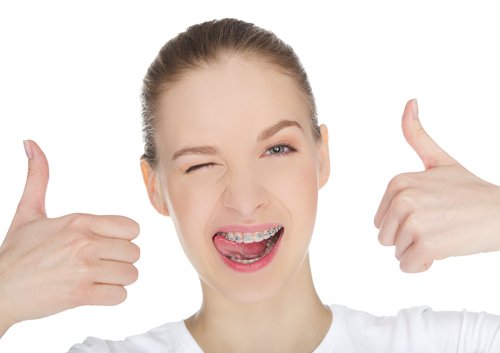October 20th, 2021

Braces can straighten your teeth to give you a more attractive smile for life. The process can take 18 months to two years or more, and this amount of time can seem unending when you first get your braces. Counting down your brace time can help the time pass more quickly and build the excitement for when you finally get your braces removed.
Make a Wall Calendar
Crossing out each day on a calendar is a standard way of counting down time. You can make this more personal by designing your own calendar to help you count down. Use an online customization service to upload photos or designs for each month. Each month’s picture can also display the number of months remaining until you expect your braces to come off.
Schedule Rewards
When you receive regular rewards for continuing to wear your braces, they can seem less burdensome. Plan to buy yourself a reward every month that you wear your braces for the duration of the treatment. The time will pass much faster when you feel you are earning rewards for your patience.
Lengthen a Paper Chain
Use strips of paper to make the links of your chain, and add a new link each week to lengthen the chain. Before sealing each new strip of paper into a circle, write on it a reason why you are getting your teeth straightened, or an event in the future when you will appreciate your straight teeth as you smile.
Use a Wall Hanging
Purchase a large pad of blank white paper. Write a “0” on the bottom sheet and a “1” on the next, and continue until you reach the number of days remaining in your treatment. Rip off the top sheet each day to see how many days are left and remind yourself of the progress you are making.
Find a Buddy
If any of your friends get braces around the same time as you, share the experience. Make a pact to celebrate each trip to Garai Orthodontic Specialist when one of you receives news about your progress.
October 6th, 2021

Fall can be a really enjoyable time of the year for you and your family. The kids are back in school, the leaves are changing, and Halloween approaches. This holiday is a lot of fun for kids, but Garai Orthodontic Specialist wants to remind you it can also be risky, especially for your child’s braces. If you have kids with braces, take a look at the following tips from the American Association of Orthodontics (AAO) on how to keep your kids and their teeth safe this Halloween season.
Important Safety Tips
Trick-or-treating is a favorite Halloween activity for kids everywhere. While it is a great holiday tradition for children, it comes with some potential risks. To keep your kids safe while trick-or-treating, try following these simple guidelines:
- If you have young children, make sure they are accompanied by an adult at all times.
- You or your kids should always carry flashlights.
- For costumes, try to include a light-colored or reflective element that can be easily seen by oncoming traffic.
- Avoid costumes that include a mask, especially for younger children. These can pose a safety hazard for both the wearers and the people around them.
- Tell your kids not to eat any of their candy until they arrive home. Be sure to inspect all treats carefully before letting them dig in.
Following these guidelines can help you keep your kids safe on Halloween.
Halloween Treats to Avoid if Your Child Has Braces
If your kids have braces, you’ll want them to steer clear of certain treats on Halloween. Many candies can cause damage to braces, so it’s wise to avoid them while you’re celebrating this fun holiday. Here is a list of treats to stay away from:
- Hard candies
- Chewy candies
- Nuts
- Caramel
- Licorice
- Jelly beans
- Taffy
- Bubblegum
- Hard pretzels
- Popcorn
Some of these treats may seem harmless, but all of them have the potential to bend or break your child’s braces. So it’s best to avoid eating them altogether.
Braces-Friendly Halloween Treats
If your children have braces, they may feel like they can’t enjoy any treats on Halloween. However, there are plenty of braces-safe treat options for them to choose from, including the following:
- Soft chocolate
- Peanut butter cups
- Gelatin treats
- Ice cream
- Smoothies
- Root beer floats
- Apple cider
These are just a few braces-friendly alternatives to traditional Halloween candy. Helping your kids have a fun and safe Halloween—while at the same time protecting their braces—can be easy if you follow these simple tips and guidelines. Help your kids enjoy the holiday without having to visit Dr. Allen Garai & Dr. Karen Tratensek for repair work on damaged braces!
September 22nd, 2021

You may have noticed that we specialize in orthodontics and dentofacial orthopedics. And while most people we talk to have heard of orthodontics, many are confused by the dentofacial orthopedics part of the title. Today, Dr. Allen Garai & Dr. Karen Tratensek and our team thought we would explain the difference.
While orthodontics entails the management of tooth movement, dentofacial orthopedics involves the guidance of facial growth and facial development, which occurs for the most part during childhood, and is a reason why kids are often the best candidates for receiving dentofacial orthopedic therapy. Dr. Allen Garai & Dr. Karen Tratensek will examine and monitor your child’s growth to determine when starting treatment will be most effective. If your child begins orthodontic treatment before his or her adult teeth have erupted, it is known as Phase-One treatment. During this phase, Dr. Allen Garai & Dr. Karen Tratensek will use treatments designed to correct your child’s jaw growth and make sure that the jaw bone is properly aligned before beginning the next phase of treatment, which usually involves placing braces to straighten your child's teeth.
Dentofacial orthopedics is also used to treat adult patients at Garai Orthodontic Specialist, however, this process may involve surgery. With our younger patients, we know the jaw bones are still forming, making it easier for our team at Garai Orthodontic Specialist to control bone growth and tooth movement. Adults, however, are a different story; their bones are no longer growing, and their jaw bones have hardened, so it is more difficult to adjust the bite and move teeth into proper alignment. Dr. Allen Garai & Dr. Karen Tratensek may recommend surgery to adjust the jaw bone and establish the proper bite alignment before beginning treatment.
Because our team at Garai Orthodontic Specialist is skilled in both areas, we are able to diagnose any misalignments in the teeth and jaw as well as the facial structure, and can devise a treatment plan that integrates both orthodontic and dentofacial orthopedic treatments.
We hope that helps! To learn more about dentofacial orthopedics, and to find out if this type of treatment is right for you, please contact our Vienna, VA & Great Falls VA office and schedule an initial consultation for you or your child. It’s never too late to get a great smile, and we can’t wait to help you or your child get started.
September 15th, 2021

While it’s normal to feel self-conscious, there is no reason to avoid photos just because you wear braces. Many people wear braces and you do not need to be embarrassed about them. There are also ways you can enjoy your photos without hiding your smile.
Make it Fun
Dr. Allen Garai & Dr. Karen Tratensek and our staff offer rubber bands for braces in a wide range of colors. Choose your favorite color and wear it with pride. You can mix and match your colors too. For Valentine’s Day, try alternating red and pink bands. For the Fourth of July, use red, white, and blue!
Bands are also available in neon colors and glow-in-the-dark designs. Your imagination is the only thing holding you back. You might want to avoid using dark green bands, though. It makes it look as though you have broccoli stuck in your teeth. Gross!
Make them Disappear
If your braces still really bother you in photos, technology can quickly solve the problem. A photo-editing program, or even a simple paint program, can easily erase your braces. Zoom in on your teeth, pick your natural tooth color with the dropper, and paint your braces away.
If you have a significant amount of metal in your braces, try to avoid close-ups with flash. The flash can reflect off the metal. The important thing to remember is how good your teeth will look and feel once your orthodontic work is complete. Dr. Allen Garai & Dr. Karen Tratensek and our staff can also show you options for braces that are not as visible as the traditional style.






 Website Powered by Sesame 24-7™
Website Powered by Sesame 24-7™